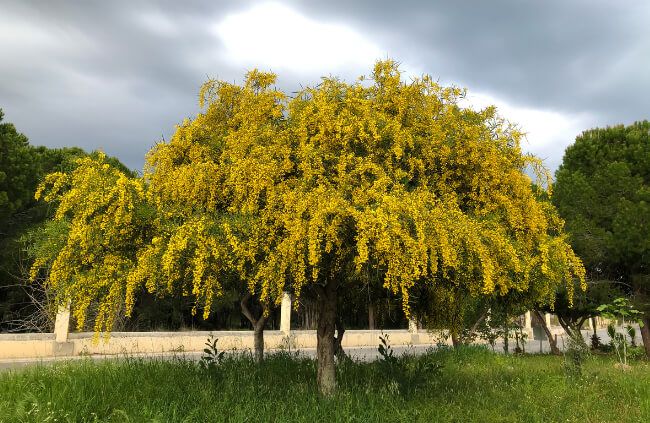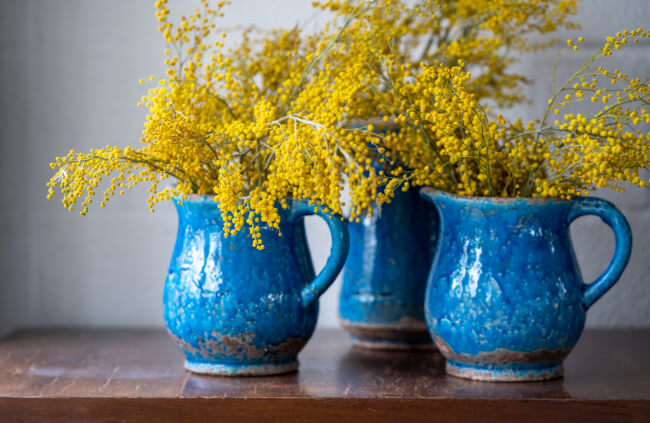If you’re looking to add some vibrant spectacle to your garden, I believe there aren’t many native ornamental garden specimens that feature such all-around stunning characteristics like Acacia dealbata does.
This globally adored flowering tree is prized for its glaucous blue-green to silvery grey fern-like foliage which sits gently amidst its profusions of clustered bright-yellow powder puff flowers from spring to early summer.
Apart from these already impressive features, this tree species does also produce a fresh-smelling fragrance from its new leaves and flowers that can encompass the entire garden, further elevating your outdoor spaces and sensory admiration for this plant.
In this article, I will explain everything you need to know in order to grow and care for this globally celebrated native species in your garden.
More...

Family: | Fabaceae |
|---|---|
Genus: | Acacia |
Species: | A. dealbata |
Common Names: | Silver wattle, yellow mimosa tree |
Origin: | Australian Native |
Location: | Outdoor |
Type: | Tree |
Growth: | 5 to 15 metres tall and wide |
Sun requirements: | Full sun |
Foliage Colour: | Green |
Flower Colour: | Yellow |
Flowering: | Spring to early summer |
Maintenance level: | Low |
Poisonous for pets: | Non-toxic to cats and dogs |
Introducing Acacia dealbata
The tree's ferny foliage can quickly add interest and texture to gardens whilst its golden-yellow fluffy blooms can add unparalleled ornamentation to outdoor spaces.
Once matured, this tree will sport a graceful high canopy that is adorned with dense fern-like foliage and large clusters of yellow flowers that all sit atop an attractive blue-green variegated trunk and branches. What’s not to love, right?
Botanically labelled Acacia dealbata, the tree's common names include silver wattle and the yellow mimosa tree. Forming part of the Fabaceae family, this species is native to south-eastern Australia where it occurs largely in the open woodlands of New South Wales, Victoria, Tasmania and the Australian Capital Territory.
Today, it is a widely cultivated ornamental plant in warm regions across the globe. The Acacia genus consists of around 1300 species. Other very popular species include A. floribunda and A. howittii. Also see our main article on Acacia for more varieties to choose from.
Landscaping with Acacia dealbata
Silver wattle thrives in warmer climates that do not experience harsh prolonged frosts so it suits Mediterranean, warm temperate and tropical to subtropical landscapes best.
Considered fast-growing, this evergreen tree will typically grow to about 5 to 15 metres tall and wide when cultivated in residential gardens, however, it can grow up to 30 metres tall if given the ideal space and conditions.
Its nectar-rich blooms will attract local bees, butterflies and other beneficial pollinators to the garden.
This tree is most commonly planted as an ornamental feature specimen to add that wow factor outdoors. As an added benefit, the golden inflorescences make for stunning cut flowers for floral arrangements around the house or for functions. The cut flowers are usually referred to as Mimosas.
How to Grow Acacia dealbata

Yellow mimosa trees are best grown from seed or propagated using cuttings. This species is known to grow readily from seed but the hard seed cases will need to be softened prior to sowing to improve the chances of germination.
Seeds are best sown in spring or autumn to avoid the hottest and coldest months of the year. Cuttings are not as reliable but still successful in most cases with good conditions. Cuttings should be planted in spring.
Growing Silver Wattle from Seeds
- Prepare the seeds by pouring boiling water over them and then leaving them to cool overnight before sowing.
- Prepare seed containers filled with a quality seed-raising mix.
- Sow the swollen seeds into the mix to a depth of about 3-4mm deep.
- Mist lightly after sowing then place the seeds in a warm and sheltered location with some bright indirect light.
- Ideal seed germination temperatures are between 18-22°C.
- Keep seeds moist but never wet.
- Germination should occur within 10 to 21 days.
Acacia dealbata Propagation Using Cuttings
- Take healthy semi-hardwood cuttings from the current season’s growth after flowering.
- Each cutting should be at least 10-15 cm in length.
- Prepare well-draining containers filled with a quality potting mix then water lightly to make the mixture moist.
- Dip each cut end of the cuttings into rooting hormone then plant them into the containers until firm.
- Keep in a warm location away from strong winds and keep moist but never wet.
- Allow young plants to develop and then transplant into the garden as soon as possible.
Best Conditions for Planting Silver Wattle
A nursery plant or young plant that you’ve cultivated should be planted into the garden around spring or autumn to avoid overly harsh conditions outdoors while it adjusts.
Considering your climate, the yellow mimosa tree is only frost hardy down to about -5°C but cannot withstand prolonged frosts, especially while young. Those who live in cooler climates can consider establishing a container-grown tree that can be overwintered.

Here are the ideal growing conditions for silver wattle in gardens.
Position
This tree will thrive and look its best in full sun. Full sun will ensure the tree flowers profusely and it will also keep the foliage bursting with those silvery hues. Some shelter from strong, cold winds will also be beneficial.
Soil Conditions
While this plant can tolerate different soil types, the soil must be well-drained. In gardens, sandy-loam soil tends to be preferred with a neutral to slightly acidic pH level. Heavy clay soil should be avoided if possible. This is a good species to control soil erosion in the countryside.
Tips for Growing in Containers
This tree can be grown in large containers for use in smaller or cooler landscapes. It will grow much smaller and can even be groomed into more of a shrub with a compact and dense growth habit.
You can still enjoy impressive flushes of amber blooms as long as the tree still gets full sun and is grown in a quality, well-draining potting mix.
Caring for Yellow Mimosa Tree
Once established, silver wattle is mostly a hassle-free plant. It may require a little more attention while young and developing but in good conditions, it’s truly a beauty without requiring constant attention.
Watering Needs
Water well in the plant's first summer and during dry spells. Thereafter, it requires little supplemental water once established as it is quite drought tolerant at this point. Water only when the soil is completely dry.
Pruning Acacia dealbata
Young acacia specimens will benefit from some formative pruning to sculpt and grow them into sturdy, well-shaped trees. Once matured, prune after flowering to keep the tree looking tidy.
Lightly cut back the branches that have borne flowers then pinch away any ground-level suckers and remove any dead branches as needed.
Fertilising
While fertiliser may not be needed by acacia, you can feed your tree a low-phosphorus fertiliser formulated for native plants in spring to boost growth and increase flowering. Apply in small doses and water well.
Mulch
It can be beneficial to add a healthy layer of organic mulch around the base of the tree in summer to help with soil moisture retention and suppress weeds. Container-grown specimens will also appreciate some mulch in summer.
Acacia dealbata Pests, Problems and Diseases
This very vigorous tree is only rarely affected by disease, especially in good conditions. There are some smaller issues that you could experience but these are too, quite rare.
Spider Mites
Spider mites tend to avoid strongly scented plants like silver wattle but the leaves can attract them in some areas with poorer growing conditions.
Follow our in-depth guide to learn how to effectively prevent and get rid of spider mites.
Mealybugs
Mealybugs can be frustrating to deal with but luckily, they are easily combated. They are small pinkish-purple bugs that appear grey to white once covered in their cottony wax. These cotton-like deposits will be a good sign of infestation.
To treat, regularly apply a quality organic neem oil to the affected foliage to kill off all stages of the mealybug life cycle. Reapplication may be necessary for severe infestations.
Root Rot and Overly Moist Conditions
Overwatering or poorly drained soil can lead to root rot if left to accumulate. Root rot can severely damage trees and stunt their growth. This species in particular is very tolerant to drought so you should only water when the soil is completely dry.
Too much moisture can also lead to those beautifully luscious leaves yellowing and falling off the tree.
Acacia dealbata Frequently Asked Questions

Where is the best place to plant an acacia tree?
Acacia will perform best planted in well-drained soil of sand or loam with a neutral to slightly acidic pH balance. They thrive positioned in a sheltered spot that gets full sun.
Is Acacia dealbata a tree or shrub?
This specific species of Acacia is more of a tree than a shrub. It can be groomed into a shrub while young but will be difficult to keep there unless grown exclusively in a container. It is best grown as a medium-sized tree in sunny gardens.
What is the lifespan of an Acacia dealbata tree?
These gorgeous evergreen trees can live between 20 and 40 years, depending on conditions. While that may seem short-lived for a tree, they are easily propagated so you can ensure you never go without those golden-yellow bursts of blooms in the garden.
How much space do acacia trees need?
These trees will need about 9 metres of space between one another and away from buildings or structures.
How fast does Acacia dealbata grow?
This vigorous, fast-growing species can be expected to grow around 25 cm to 50 cm or more each year, especially in ideal conditions.
What are the uses of Acacia dealbata?
This decorative tree is most commonly grown as an ornamental and is cultivated commercially for its bright-yellow flowers and the essential oil they contain. It is also a good species for soil stabilisation and thus reduced soil erosion.
Accelerate Your Gardens Native Spectacle with Acacia dealbata
Whether for its useful applications as a decorative tree or its breathtaking profusions of golden-yellow blooms, Acacia dealbata has a lot to offer outdoor spaces. The silver wattle is an excellent pick for those looking to add some interest and texture to their gardens without the hassle of high maintenance.
The powder puff yellow flowers contrast beautifully with the tree’s ferny foliage. I can endearingly recommend the all-around stunning Acacia dealbata to almost anyone.
Published on June 18, 2023 by Nathan Schwartz
Last Updated on February 23, 2024




